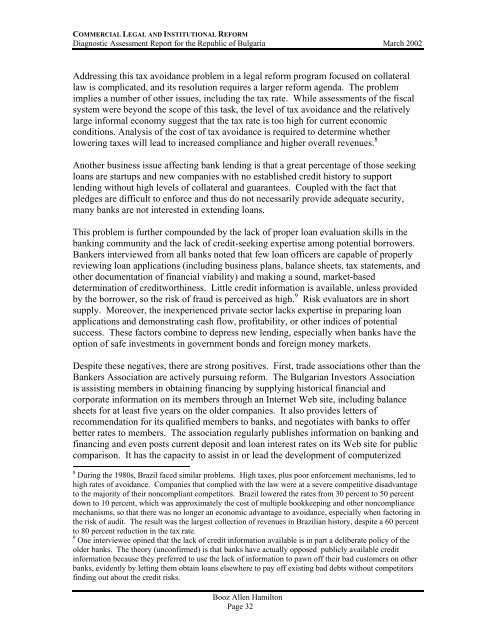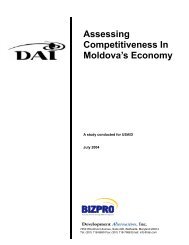Commercial Legal And Institutional Reform (CLIR) - Economic Growth
Commercial Legal And Institutional Reform (CLIR) - Economic Growth
Commercial Legal And Institutional Reform (CLIR) - Economic Growth
You also want an ePaper? Increase the reach of your titles
YUMPU automatically turns print PDFs into web optimized ePapers that Google loves.
COMMERCIAL LEGAL AND INSTITUTIONAL REFORM<br />
Diagnostic Assessment Report for the Republic of Bulgaria March 2002<br />
Addressing this tax avoidance problem in a legal reform program focused on collateral<br />
law is complicated, and its resolution requires a larger reform agenda. The problem<br />
implies a number of other issues, including the tax rate. While assessments of the fiscal<br />
system were beyond the scope of this task, the level of tax avoidance and the relatively<br />
large informal economy suggest that the tax rate is too high for current economic<br />
conditions. Analysis of the cost of tax avoidance is required to determine whether<br />
lowering taxes will lead to increased compliance and higher overall revenues. 8<br />
Another business issue affecting bank lending is that a great percentage of those seeking<br />
loans are startups and new companies with no established credit history to support<br />
lending without high levels of collateral and guarantees. Coupled with the fact that<br />
pledges are difficult to enforce and thus do not necessarily provide adequate security,<br />
many banks are not interested in extending loans.<br />
This problem is further compounded by the lack of proper loan evaluation skills in the<br />
banking community and the lack of credit-seeking expertise among potential borrowers.<br />
Bankers interviewed from all banks noted that few loan officers are capable of properly<br />
reviewing loan applications (including business plans, balance sheets, tax statements, and<br />
other documentation of financial viability) and making a sound, market-based<br />
determination of creditworthiness. Little credit information is available, unless provided<br />
by the borrower, so the risk of fraud is perceived as high. 9 Risk evaluators are in short<br />
supply. Moreover, the inexperienced private sector lacks expertise in preparing loan<br />
applications and demonstrating cash flow, profitability, or other indices of potential<br />
success. These factors combine to depress new lending, especially when banks have the<br />
option of safe investments in government bonds and foreign money markets.<br />
Despite these negatives, there are strong positives. First, trade associations other than the<br />
Bankers Association are actively pursuing reform. The Bulgarian Investors Association<br />
is assisting members in obtaining financing by supplying historical financial and<br />
corporate information on its members through an Internet Web site, including balance<br />
sheets for at least five years on the older companies. It also provides letters of<br />
recommendation for its qualified members to banks, and negotiates with banks to offer<br />
better rates to members. The association regularly publishes information on banking and<br />
financing and even posts current deposit and loan interest rates on its Web site for public<br />
comparison. It has the capacity to assist in or lead the development of computerized<br />
8 During the 1980s, Brazil faced similar problems. High taxes, plus poor enforcement mechanisms, led to<br />
high rates of avoidance. Companies that complied with the law were at a severe competitive disadvantage<br />
to the majority of their noncompliant competitors. Brazil lowered the rates from 30 percent to 50 percent<br />
down to 10 percent, which was approximately the cost of multiple bookkeeping and other noncompliance<br />
mechanisms, so that there was no longer an economic advantage to avoidance, especially when factoring in<br />
the risk of audit. The result was the largest collection of revenues in Brazilian history, despite a 60 percent<br />
to 80 percent reduction in the tax rate.<br />
9 One interviewee opined that the lack of credit information available is in part a deliberate policy of the<br />
older banks. The theory (unconfirmed) is that banks have actually opposed publicly available credit<br />
information because they preferred to use the lack of information to pawn off their bad customers on other<br />
banks, evidently by letting them obtain loans elsewhere to pay off existing bad debts without competitors<br />
finding out about the credit risks.<br />
Booz Allen Hamilton<br />
Page 32

















